Aerobic Exercise
Aerobic exercise, also known as cardio, is a type of physical activity that gets your heart pumping and your blood flowing. It uses large muscle groups in a rhythmic and sustained manner, requiring your body to use oxygen to produce energy.
What is an Aerobic Exercise?
Aerobic training is sometimes known as “cardio” — an activity that needs the pumping of oxygenated blood by the heart to supply oxygen to functioning muscles. Improved breathing and heart rate that can be maintained throughout the exercise session are the results of aerobic exercise.
In contrast, anaerobic (“without oxygen”) activity is an activity that causes you to be fast out of breath, like sprinting or raising a heavy weight. Cardio machines, spinning, running, swimming, walking, hiking, aerobics classes, dancing, cross-country skiing, and kickboxing are a few examples of aerobic exercises.
There are many different types. Aerobic activity not only enhances fitness; it also has been known to help both physical and emotional health. Aerobic workouts can help prevent or decrease the chance of developing some cancers, diabetes, depression, cardiovascular illness, and osteoporosis. An aerobic exercise program should be simple, practical, and realistic.
Types of Aerobic Exercise
The level of fitness determines the ideal aerobic activity. A moderate-intensity exercise that takes place over a set amount of time and requires oxygen is called aerobic training. The most popular activity among young people these days is practicing aerobics.
Engaging in aerobic exercise is not only enjoyable but also highly beneficial to one’s health. Several forms of aerobic exercise exist, including fitness, swimming, kickboxing, inline skating, bicycling, water aerobics, step aerobics, and more.
Here we have more examples:
Low-Impact Aerobic Exercise
Some people are incapable of doing high-intensity exercise due to a variety of medical conditions or issues. Low-impact aerobics is the ideal exercise option for these people. Large muscle groups are worked during low-impact aerobic exercise through rhythmic motions.
Water Aerobic Exercise
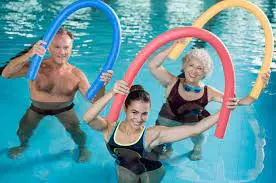
During the summer, exercising in the pool is a pleasant way to stay fit. Some who take their water aerobic exercise seriously claim that it’s a great way to burn off excess body fat and develop inner strength, even though the workout may just seem like one splashing around in the pool. Health experts often declare that water aerobic exercise is beneficial for individuals with arthritis and other conditions.
Step Aerobics
This type of exercise is a fascinating new move of the aerobics technique. Traditional aerobics are performed on the floor, where you learn a variety of dance moves like the Jazz Square and Pony, which are frequently performed in sets of four, with two steps moving you in one direction and two steps in the opposite direction.
Dance Aerobics
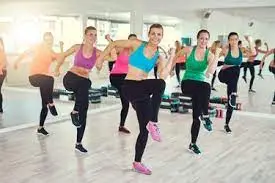
Aerobic dance combines dance steps and physical activity into routines that are performed to music. Numerous dance styles are employed, such as disco, jazz, and ballet.
Aerobic dance classes combine the development of muscle and stretching exercises with fat-burning aerobics. You have your foot placed firmly on the ground. Compared to intermediate and advanced classes, this type of aerobic exercise is less rapid and easier to perform.
Sport Aerobics
Sport Aerobics is a hard and competitive sport that has a special connection between aerobic choreography and gymnastics features. This sport generates a possibility for adolescents and adult individuals to compete in a sport that requires less risk than gymnastics while keeping the artistic grade and fun of aerobics.
Here we describe details of aerobic exercise:
At-home aerobic exercise
aerobic Exercises can be performed at home. Many of them also require little to no tools. Always warm up for five to ten minutes before starting any kind of exercise.
Jump rope
You should make sure you have enough space before using jump rope circuits outdoors or indoors. Your circuit program should be finished in 15 to 25 minutes.
Should you be a beginner: Jog forward, swishing the jump rope beneath your feet and above your head. For fifteen seconds, try this. After that, continue to swing the jump rope as you jog in the opposite direction backward.
Give it a try for fifteen seconds. As you would when doing jumping jacks, stand with the rope in the middle of the exercise and bounce back and forth, bringing your feet to the sides and back to the center. Give it a try for fifteen seconds. Every 15 seconds, take a break between sets.
Repeat eighteen times. You can complete each set of exercises in 30 seconds if you’re an intermediate exerciser, with a 30-second break in between. The advanced circuit should be done for 60 seconds at a time, followed by a 60-second break.
Aerobic strength circuit
The goal of this aerobic rotation is to raise your heart rate. Spend a minute performing the following strength exercises:
- squatting
- lunges
- pushups
- triceps dips
- torso twist
As your active rest, jog or march still for one minute after that. Two or three times over, repeat the circuit. In between circuits, you can take up to five minutes of rest. Stretch a little afterward to help you cool down.
Running or jogging
Run for five to ten minutes twice a week if you’re new to exercising, and as you get better, progressively increase the time.
Keep a conversational pace while you run. You can alternate between one minute of walking and five minutes of jogging to start. To avoid injury, you must stretch after a workout.
Walking
If you only like to walk then go for a 150-minute walk in a week. Walking for thirty minutes every day for five days a week can be used to achieve this. As an alternative, walk quickly for ten minutes three times a day. You can also keep an eye on your daily step count by using a fitness tracker.
If 10,000 steps a day is your goal, start with your base, or the amount of steps you currently take, and increase it gradually. Consequently, once you’ve established your basis, add 500–1,000 steps. Then, for a period of one to two weeks, allow yourself an additional 500–1,000 steps per day.
Aerobic gym exercises
Your neighborhood gym is a great spot to do some aerobic exercise. They probably have stationary bikes, treadmills, and ellipticals. There’s a chance you could even swim laps in the pool. When in doubt about how to use a specific piece of exercise equipment, always consult a specialist or trainer.
Swimming
Consider swimming as an aerobic exercise if your gym has a pool. If you’re prone to injuries, this low-impact exercise is a wise choice. Additionally, without putting additional strain on your body, you’re developing your strength and stamina, increasing your heart rate, and strengthening your muscles. Starting with swimming circles with a single stroke, such as freestyle, is one method.
As you gain experience swimming, add more strokes. For example, one to four laps of backstroke or breaststroke could come after one to four laps of freestyle. If you’re tired between laps, stretch yourself out on the edge of the pool. Always follow the guidelines and safety instructions that are posted at the pool.
Stationary bike
Riding a stationary bike is another low-impact fitness option. Static bikes not only offer a good cardiovascular workout and ease of use, but they also aid in building leg strength. Many gyms and fitness centers provide cycling classes that use stationary bikes. Even so, you can still benefit from a stationary bike workout if you choose not to sign up for a class.
After warming up with five to ten minutes of easy riding and stretching, increase your speed to 75 to 80 rotations per minute (RPM) and aim for 20 to 30 minutes of consistent cycling. Give it five minutes to settle. Continue to the very end.
Elliptical
The elliptical machine is easy to use once you get the hang of it, despite its intimidating appearance. After warming up for five to ten minutes at a gentle rhythm, maintain an erect posture and cycle the machine with your legs.
Never look down at your feet; instead, always look forward. Keep your back arched and your abdominal muscles taut. Once the machine has cooled down, stretch. Increase the machine’s resistance to make the workout more challenging.
Aerobic class workouts
If you don’t like working out alone, a class could provide an encouraging and supportive environment. Start by going to your local fitness center’s group classes two or three times a week. You can always go more frequently later if you enjoy the workout.
Cardio kickboxing
Cardio kickboxing is a combination of martial arts, boxing, and aerobics. Running or a strength-training exercise like pushups or jumping jacks could be the first exercise in your lesson. After that, a series of punches, kicks, and hand strikes will make up the main workout. After working out, always stretch and cool down.
Zumba
If you like to dance, Zumba is a great option for an aerobic workout. Your instructor will lead the class through basic dance moves to upbeat music after a quick warm-up. The final steps will be a cool-down and stretching.
You have to wear footwear. Make sure to drink plenty of water the entire time in class. You can always take a break and come back if you’re tired.
Indoor cycling class
Unlike a relaxing bike ride, a cycling class will increase your heart rate. It may include both resistance and climb (incline) sections for maximum training effects. This will result in your muscles getting stronger and more toned. For certain classes, cycle shoes that “clip” into the bike are necessary. Usually, you can hire this from your facility.
Most classes run 45 to 60 minutes and include warm-up, cool-down, and stretching. Water should be brought to class. If you’re a beginner, you can take a rest from pedaling by reducing the bike’s resistance and using gentle strokes.
Aerobic Exercise Moves
Aerobic activity is good for each person. Aerobic fitness moves combine rhythmic exercise or dance moves with stretching and strength workout practices to provide a full-body workout experience.
Here are some moves you need to give your body a full aerobic workout:
Warm-Up
Warm-up exercises that increase heart rate from resting to the warm-up phase gradually increase in intensity and energy. The most common aerobic warm-up is walking or marching in place. To add intensity, and energy, and to improve blood flow to the muscles, deepen your steps into lunges after the warm-up.
Stepping side to side and moving the arms at waist level or above are the other initial phase motions. During the warm-up phase, aerobic exercises need to include a gentle stretching of all major muscle groups, including the lower back.
An aerobic workout should begin with five to ten minutes of warm-up. Warming up the body’s core, muscles, and joints is the aim of the warm-up phase, which also serves to prime the body for the training phase of the exercise.
Aerobic Activity in the Zone
Your body moves closer to your target heart rate during the next phase of your workout. Both the movement’s pace and intensity increase as they progress. It’s common knowledge that certain aerobic exercises can increase intensity; for example, changing one’s body’s momentum and moving in the opposite direction is a high-intensity exercise.
This explains why aerobic routines include a lot of up-and-down and back-and-forth movements during the middle portion of the exercise. Another high-intensity aerobic exercise is lifting one’s body weight. High-intensity movements include leaping, hopping, and charging a move. This portion of the workout should last between fifteen and twenty-five minutes, with the intensity increasing at the beginning, peaking in the middle of the session, and decreasing after this aerobic workout phase.
Cool-Down Aerobic
The cool-down and stretch periods come last in an aerobic exercise program. The vigorous motions come to an end, the workout picks up speed, and the exercise resumes the milder, warm-up movements. Exercise shouldn’t be stopped suddenly without this cool-down period.
You may experience vertigo and then fade out. Rather than increasing your exercise intensity, decrease it until your heartbeat is less than 100 beats per minute. After completing your aerobic exercise, stretch every muscle you worked to help it regain its natural length, improve your flexibility, and maintain the tone and flexibility of your muscles.
The beginning
Breathing is the basis of everything. A healthy adult typically breathes in and out at a rate of 7 to 8 liters per minute. After you breathe in, the oxygen in the surrounding air—which has an oxygen content of about 20%—is filtered by tiny tube branches called bronchioles before entering the alveoli. The tiny sacs known as alveoli are where oxygen diffuses or enters the blood. It’s directly to the heart from there.
Aerobic routine
Cardiovascular Exercise Millions of Americans train with aerobics treatments in one way or another, and aerobics has evolved into a fun sport that can be done for weight loss and fitness maintenance. Low-impact aerobics routines are the most popular, and dance is another popular component that calls inspiration from ballet, salsa, and even hip-hop. Not only does the aerobic routine strengthen the heart and lungs, but it also increases cardiopulmonary efficiency.
It should also help to lower cholesterol, improve blood circulation, and lessen anxiety and tension. Being a fairly strenuous exercise regimen, aerobics may call for careful planning and selection of appropriate equipment to prevent injury.
For those who are new to fitness, here is an example schedule:
Day one:
A pleasant, bright place is just a twenty-minute stroll away. A pleasant walking area should be found, and pollution should be avoided. If none is available, you might be able to find one by visiting a park, beach, grassland, or rural area where there is less pollution.
The ability to maintain an engaging conversation is necessary. You won’t burn calories as effectively if you are in oxygen debt, so start slowly. Stretching for ten or fifteen minutes should be done after you return.
It is advisable to perform it regularly to avoid storing excess calories in your butt or thighs. The brain starts to believe that the body is active and that its metabolism needs to increase when you start engaging in periodic activity.
The brain will then reach a more advanced metabolic state. You will produce more free radicals as your routine of physical activity intensifies. This is the justification for working with nutrition as well, as you need to raise antioxidant levels to protect the body from free radical damage.
Day two:
Just spend ten to fifteen minutes stretching. Maybe you could decide to swim for ten or fifteen minutes if you find a pool.
Day three:
For 25 minutes, walk quickly. Ten minutes is all it takes to get a great stretch, but if you have it down, stretch for fifteen.
Day four:
Spend at least ten minutes stretching and twenty minutes swimming.
Day five:
You might miss one or walk maybe longer and easier or harder depending on how you feel.
Day six:
Walk a good distance faster for 30 minutes. If you feel dizzy when walking, stop after you break into a light sweat, and stretch for a few minutes. Regarding the legs and gluteus muscles. After that, carry on until you have a good ten minutes of stretching.
Day seven:
If you didn’t miss a day, think about taking a relaxing walk, going for a swim, stretching, or doing something fun with loved ones. If you experience any anxiety during the week, take a break and either stretch or go swimming.
Follow this program until you can walk for thirty minutes without experiencing any breathlessness. For most people, this can last two weeks, but for some, it can last up to four weeks. If it takes longer, commit to 25 minutes a day for two months before moving on to the next level. You can move on to the next level if, after two weeks, your body continues to serve you well.
Continue the next day by going for a thirty-minute vigorous walk. We will now start burning fat. You should now be working out for about 45 minutes at a time. Your difficult days pass by just as quickly as your easy days did at the beginning as you grow stronger every time. During the first few months, walking can increase to five times a week, depending on your body. This isn’t as important as it will be later on when we begin the weightlifting, jogging, or strengthening schedule.
Six to eight weeks:
Start your strength-training regimen after a period of six to eight weeks. Remember to pay attention to your body. Take eight weeks if, after six weeks, you’re still not quite ready. With this addition to your program, you can go in two different directions, at varying degrees of intensity based on your body and your capabilities.
You may now start running if you are able and willing to run for your specific goals. Start with 20 minutes a day of easy jogging and every other day of weight training. At this time of year, running and weight training should be done three days a week at the latest. However, there is some evidence that suggests we could still function well with just two days of weight training. Take a day off from work. Your rest day should consist of a light workout, stretching, swimming, or relaxing with the family.
Getting to the heart of it
The heart is made up of two atria, two ventricles, which fill with blood and pump it out, as well as some extremely active coronary arteries. The lungs, as you just learned, supply the heart with fresh oxygen because of all this activity. After the heart has used up all of its resources, it pumps blood, oxygen, and other nutrients to all of the organs, muscles, and tissues that require them via the circulatory system and the large left ventricle.
A Whole heart lot of pumping going on
In a 70-year lifetime, the average heartbeat is 60–80 beats per minute, 100,000 beats per day, over 30 million beats annually, and roughly 2.5 billion beats per minute! Blood, oxygen, and numerous other nutrients necessary for life are sent throughout your body with each heartbeat. The heart pumps roughly five liters of blood per minute in a healthy adult on average.
Oxygen consumption and muscles
It is vital that the blood pump so much oxygen. In research, it’s referred to as the volume of oxygen consumed or VO2. The milliliters per kilogram of body weight, or ml/kg/minute, is the unit of measurement for the amount of oxygen the muscles take up from the blood.
Muscles are powered by fuel, just like automobiles; instead of burning petrol, our muscles burn fat and carbohydrates. Oxygen is necessary because, once it enters the muscle, it is used to burn fat and carbohydrates for fuel to keep our engines running. We can burn more, stay fitter, and exercise for longer periods because of our efficient fuel-burning ability.
Aerobics and Fitness
On a maximal treadmill test, where you walk as fast as you can, the average adult who is sedentary will use almost 35 milliliters per kilogram per minute of oxygen. In other words, for every kilogram of body weight, the person is ingesting 35 milliliters of oxygen per minute.
That will get you through the day, even though top athletes can reach values as high as 90 ml/kg/minute! Not only do they have good genes, but they also train hard. When they do, their bodies adapt accordingly. The good news is that mere mortals’ bodies adapt to training just like everyone else’s does.
The heart pumps blood harder and with a greater volume with each beat (larger stroke volume). Professional athletes have more than twice the volume of strokes found in the general population. But it’s not all like that. Longer filling times are also possible because conditioned hearts pump more efficiently and have bigger masses and diameters (the heart is a muscle that grows larger with exercise). The heart can pump more blood into the chambers before each beat, which is beneficial.
A larger stroke volume reduces the need for the heart to beat as quickly to meet the demands of exercise. Efficiency is increased with fewer beats and a higher stroke volume. Consider a pump that removes water from a flooded basement. If the pump can move more water through each cycle, it will function better and last longer than if it must move water through each cycle more quickly and with strain. Athletes’ hearts have low resting heart rates—sometimes as low as 40 beats per minute, compared to the average of 60–80 beats per minute and a slower heart rate during exercise, which is caused by high stroke volume.
Your muscles are located downstream from the heart, and regular aerobic exercise improves your muscles’ ability to consume oxygen (keep in mind that “consuming” oxygen refers to the muscles’ removal of oxygen from the blood).
An increase in the quantity and activity of the enzymes that carry oxygen from the bloodstream into the muscle is the cause of this. Envision a muscle surrounded by one hundred oxygen molecules.
If the muscle can ingest all 100 molecules rather than just 50, you’re twice as fit. Put another way, if your VO2 max is 60 ml/kg/min and theirs is 30 ml/kg/min, then you are twice as fit as they are. You’ll perform better in this situation because your muscles won’t exhaust oxygen as quickly, giving you more endurance.
Inside the muscle, the number and activity of mitochondria increases. Your cells’ power plants are called mitochondria. To keep you going, they handle all the heavy lifting. To burn the fat and carbs that propel you forward, they use oxygen. The good news is that, in response to regular aerobic exercise in adults of all ages, they increase in number and activity by as much as 50% in a matter of days to weeks.
Fat and carbohydrate-burning
Our bodies burn fat and carbohydrates as fuel. You can get more energy and go farther on a gram of fat than a gram of carbohydrate because fat is a high-test food, containing 9 calories per gram compared to 4 for carbohydrates. Because fat is such an effective fuel and because it feels good to shed some extra weight, you want to burn fat! The problem is that because fat is thicker than carbs, burning fat requires more oxygen.
The good news is that regular aerobic exercise improves your body’s ability to use oxygen and burn fat; as I mentioned earlier, you have more mitochondria, your heart pumps blood more efficiently, and your muscles use more oxygen.
Difference Between Aerobic and Anaerobic Exercise
Aerobic Exercise is any activity that elevates your breathing and heart rate, but not to the point where you are unable to continue for more than a few minutes. “WITH OXYGEN” is what AEROBIC and “WITHOUT OXYGEN” signify, respectively. When you perform anaerobic exercise, such as lifting weights to increase your strength for sprinting or climbing a long flight of stairs, you quickly become out of breath.
The various advantages of aerobic exercise are explained below:
- Improve heart function and decrease resting heart rate
- Improve lung function
- Improve oxygen supply throughout the body
- Improve circulation
- Lower high blood pressure (hypertension)
- Decrease inflammation throughout the body
- Improve mood and energy
- Reduce your blood sugar
- Lower high cholesterol and triglycerides
- Improve weight loss
- Building stronger bones.
- Enhancing your muscle strength, endurance, and flexibility.
- Enhancing your balance.
Cancer prevention
- Colon cancer. It is clear from research that individuals who engage in physical activity have a 30%–40% lower risk of developing colon cancer when compared to those who do not. It seems that moderate-to-intense physical activity for 30 to 60 minutes a day can lower the risk; additionally, a dose-response relationship indicates that the risk decreases with increasing physical activity. cancer of the breast. There is a fair amount of evidence to suggest that women who engage in physical activity experience a higher risk reduction than women who do not.
- Similar to colon cancer, it seems that moderate-to-intense physical activity lasting 75–150 minutes per day is necessary to lower the risk, and there probably is a dose-response relationship as well. cancer of the prostate. Regarding whether physical activity helps prevent this cancer, the research is conflicting. cancer of the lung. Studies on the prevention of lung cancer and physical activity are comparatively scarce. The evidence that is currently available indicates that people who engage in physical activity have a lower risk of developing lung cancer; however, it is challenging to fully account for the risks associated with radon exposure and both active and passive cigarette smoking. additional cancers. The contribution of physical activity to the prevention of other cancers is poorly understood.
Cancer treatment
- For those receiving cancer treatment, there is some good news. In one study, aerobic exercise at 80% of maximal heart rate for 30 to 35 minutes per day for six weeks on five days a week decreased fatigue in women undergoing cancer treatment. In a different study, female cancer patients experienced reduced anxiety and depression after 10 weeks of aerobic exercise at 60% of maximum heart rate for 30 to 40 minutes, four days a week. Though research indicates that it can help, aerobic exercise is not a cure-all for cancer.
Osteoporosis:
- Low bone density, which is a characteristic of osteoporosis, can increase the risk of fracture. Fortunately, exercise has the potential to either increase or at least slow the rate at which bone density decreases in both men and women. There is evidence that it can be helpful, even though it may not work for everyone, or that the precise type and quantity of exercise required to reap the benefits is unknown. There’s good news for kids as well. It appears that physically active children have more bone density than children who are sedentary, and this could help prevent fractures in the future.
Depression
- Most of us who regularly work out are aware of how good it can feel to work out. Numerous research have looked into how exercise affects depression. In one of the most recent studies, it was demonstrated that riding a bike or using a treadmill for about 30 minutes each workout, three to five days a week for
- 12 weeks, reduced scores on a depression questionnaire by 47%. While the evidence suggests that it can be helpful for milder forms of depression, it is not a replacement for therapy in cases of depression that render a person unable to function, in which case medication and/or psychotherapy may be required.
Diabetes
- The Diabetes Prevention Programme is the most definitive study on how lifestyle modifications (diet and exercise) can prevent diabetes. In a three-year study, over 3,000 people at high risk for diabetes lost 12 to 15 pounds and walked 150 minutes a week, or five 30-minute walks every day. They had a 58% decrease in their risk of diabetes. Given that there are one million new cases of diabetes diagnosed annually, that is noteworthy. Insulin resistance can be enhanced by aerobic exercise as well.
- Insulin resistance is a medical condition that affects people with and without diabetes. It is characterized by the body’s improper use of insulin. One hormone that aids in the body’s cells’ conversion of glucose, or sugar, into energy, is insulin. Exercise is beneficial for reducing insulin resistance, according to numerous studies. In one, after 16 weeks of aerobic exercise, three times a week for 45–60 minutes, 28 obese postmenopausal women with type 2 diabetes saw a 20% improvement in insulin sensitivity.
Cardiovascular disease
- It would take this entire article and probably five more like it to review all of the research on the long list of studies that demonstrate aerobic exercise prevents or lowers the incidence of cardiovascular disease. Among the most significant is also among the earliest. The least fit people had much higher rates of cardiovascular disease than fit people; in some cases, the risk was twice as high, according to a study involving over 13,000 men and women.
- There are numerous ways that aerobic exercise prevents heart disease, but two of the most significant ones are by lowering blood pressure and making blood vessels more flexible, which makes them less rigid and less likely to become clogged with fat. Such outcomes have been repeatedly demonstrated. enhancing mental performance.
- promoting weight loss and/or weight management.
- Increase your “good” (HDL) cholesterol.
Strengthen the heart
- Training in aerobic exercise is a great way to strengthen your heart and lungs. The tissues in these exercises require more oxygen to be delivered to the blood.
- To meet this demand, the heart must beat more quickly, which strengthens and improves the heart’s health. The heart’s and blood’s rapid circulation helps in clearing the arteries. In other words, it lowers LDL or bad cholesterol.
The training method of aerobic exercise :
The main methods of aerobics exercise are:
- Long duration cardio
- Interval training
1. Long duration cardio
Prolonged Duration The exercises you do for a long time at a steady pace are known as cardio.
An hour-long walk at 4 mph or a half-hour run at 6 mph are two examples.
- For instance, a half-hour walk at 4 mph or a half-hour run at 6 mph.
- This burns a lot of calories
- The longer the duration, the more calories get burnt.
- It provides a daily calorie deficit that helps in losing weight.
- This is great for heavier people.
- It can be used as a starting point for workout programs as it will help increase endurance and prepare the body for further exercise.
Effects
Long Duration Cardio has more instantaneous effects.
- You experience a “burn” when performing these exercises, meaning that you burn calories while exercising.
- They don’t have any after-effects.
- The metabolic process does not increase once you quit doing this type of cardio.
2. Interval training:
Interval Cardiac Exercise Benefits
The high- and low-intensity intervals in an interval training workout alternate.
- These improve endurance and increase calorie burn like any other cardio exercise.
- These outperform Long Duration Cardio in terms of results and speed in less time.
- These can be the second step for the weight loss program and are better for people who have better endurance than beginners.
- Effects
- An ideal Interval Training session will include alternate short, high-intensity intervals and longer, lower-intensity recovery periods.
- Maximum effort—as hard as you can—is needed during high-intensity intervals (this is anaerobic exercise).
- For beginners, it can be a little less intense, which can be in a little more aerobic form.
When you experience muscle burn—a burning sensation in the muscles—you will know that you have reached your high-intensity phase.
- Results may be improved by including a few of these intervals.
- As these are very hard and taxing they are needed to be kept short and should be accompanied by longer intensity intervals (which are even called recovery intervals, as you recover from the burn of the muscle).
In a complete workout, Five to ten cycles of high and low intensity make up a full workout. According to your fitness, you can vary the lengths of each interval, the number of cycles, and the intensity of the cycle.
Heart rate training
In this example, let’s use treadmill jogging as an aerobic activity. When you jog at 6 mph, for instance, and your heart rate is 70% of your predicted maximum, you should start at that speed and either increase the speed or elevation so that your heart rate increases to 85% or even 90% for one minute. After that, you should return to your usual jogging speed for three minutes to elicit a 30% heart rate. Establish a work:active-rest ratio of 1:3. That’s a good starting point, and you will notice that your conditioning improves to the point where your heart rate will be lower at higher speeds as you increase the work intervals and decrease the active-rest ratios, as in the aforementioned examples.
It’s a good idea to plan time for rest. To avoid having to think about them while working out, put them in writing. You should only perform interval training one or two times a week at most because they are demanding exercises that require recovery time. On days when you don’t have intervals, you can still engage in aerobic exercise; just wait a day or two for your body to fully recover before performing the intervals again.
Increasing duration and intensity
Increasing aerobic activity by 10% per week is the standard guideline. It’s interesting to note that while there’s no proof to support it, the rule of thumb seems to work fairly well—that is until you exceed 10%. Consequently, the next increase should be two minutes for the following week if you are walking for twenty minutes. Ultimately, it’s critical to pay attention to your physical needs.
Try a little more if you find that increasing by 10% is very manageable. However, you will know you need to cut back to 10% increases if you find that you are exhausted for hours after working out or if your muscles are sore or achy all the time. Everything should be alright if you can learn to listen to your body.
Types of equipment used in aerobics:
Cross-country skiers, bikes, treadmill rowers, and treadmills are all useful equipment if you use them. There is evidence to suggest that certain people would prefer to work out with equipment at home instead of in a class or the gym. Everyone has a different preferred activity, so you’ll need to try a few different options before deciding on the one that suits you the best. While some people love working out at the gym, others are just as happy using their home workout equipment in front of the television.
Cross-Bike Cardio Exercise
Your 30-minute workout may become more bearable—you might even come to look forward to it—if you can find something to divert your attention. That may be the only time you get to spend 30 minutes alone during the day.
Aerobic Classes
There are three levels for aerobic classes: beginner, intermediate, and advanced. Select the level that corresponds with your health. If you are a beginner, taking an advanced class is not enjoyable. It won’t be enjoyable; it will be difficult and frustrating. To determine what’s best for you, observe the class or have a conversation with the instructor. Choosing a class time that works for your schedule is sometimes the most important factor, but make sure you don’t overload yourself.
One foot is always on the ground in low-impact classes. They might be more appropriate for beginners as they are less strenuous than high-impact exercises. These days, some classes are referred to as “high-low” or “mixed-impact,” indicating that they incorporate both high- and low-impact movements. Jumping and balancing maneuvers are part of the high-impact movement, which involves both feet leaving the ground. Continue using softer, more rhythmic, and significant music.
FAQ
How many calories are burned when doing aerobic exercise?
The amount of calories you burn during aerobic exercise depends on your weight, level of fitness, level of intensity, and the amount of time you spend working out.
Can you do aerobic exercise while doing yoga?
Vinyasa yoga, sometimes referred to as power yoga, is one style of yoga that is an aerobic practice that requires quick modifications to poses and movements.
Do aerobic activities contribute to a decrease in belly fat?
Because cardio exercises increase the effort on your heart and lungs to pump oxygen-rich blood to your working muscles, they increase your energy expenditure. By breaking down excess fat tissue and increasing your caloric intake as a result of this increased effort, you can lose fat, especially belly fat.
Does doing aerobic exercise help in weight loss?
Aerobic exercise helps you lose weight because it puts more strain on your heart and lungs to pump oxygen-rich blood to your working muscles. This increased workload causes you to burn more calories and breaks down fat tissue, which can help you lose weight.
Which types of exercises are aerobic?
Aerobic exercise is a form of physical activity that involves repetition and rhythm, aimed at targeting the major muscle groups in your body. As a result, your body uses more oxygen and your heart rate goes up. Exercises including walking, cycling, and swimming are considered aerobic exercises.
What other term would you use to describe aerobic activity?
Endurance training is another term for aerobic exercise. Your heart beats faster when you exercise. You also breathe more heavily when doing this type of exercise. Your heart and lungs become stronger and more efficient with repeated aerobic exercise.
References
- Dpt, K. G. P. (2023, September 3). What is aerobic exercise? Verywell Health. https://www.verywellhealth.com/aerobic-exercise-5218112
- Chertoff, J. (2022, July 11). 10 Aerobic exercise examples: how to, benefits, and more. Healthline. https://www.healthline.com/health/fitness-exercise/aerobic-exercise-examples
- Professional, C. C. M. (n.d.-a). Aerobic exercise. Cleveland Clinic. https://my.clevelandclinic.org/health/articles/7050-aerobic-exercise
- GoodRX – error. (n.d.). https://www.goodrx.com/well-being/movement-exercise/aerobic-exercise
- Cde, R. W. M. (2023, November 16). Aerobic exercise benefits, examples at home and what is it? MedicineNet. https://www.medicinenet.com/aerobic_exercise/article.html
- Clinic, M. P. (2023, July 11). Aerobic exercise ( cardiac exercise ) type, benefits, exercise. Mobile Physiotherapy Clinic. https://mobilephysiotherapyclinic.in/aerobic-exercise-cardio/
- Tirgar, P. (2023, December 13). What is an example of aerobic exercise? Mobile Physiotherapy Clinic. https://mobilephysiotherapyclinic.in/what-is-an-example-of-aerobic-exercise/

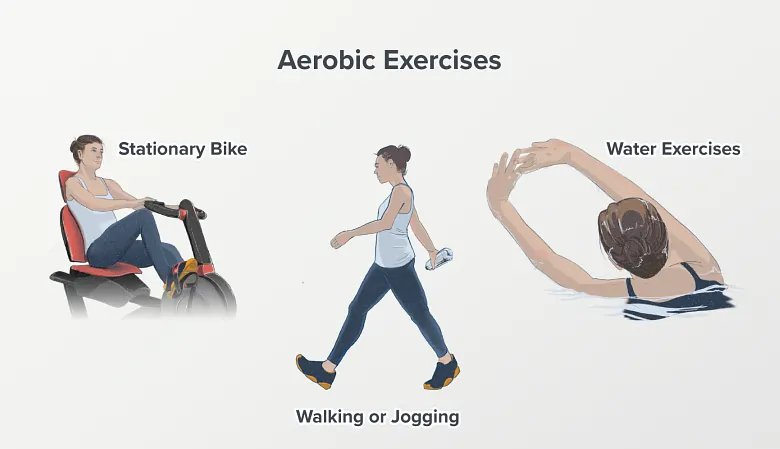
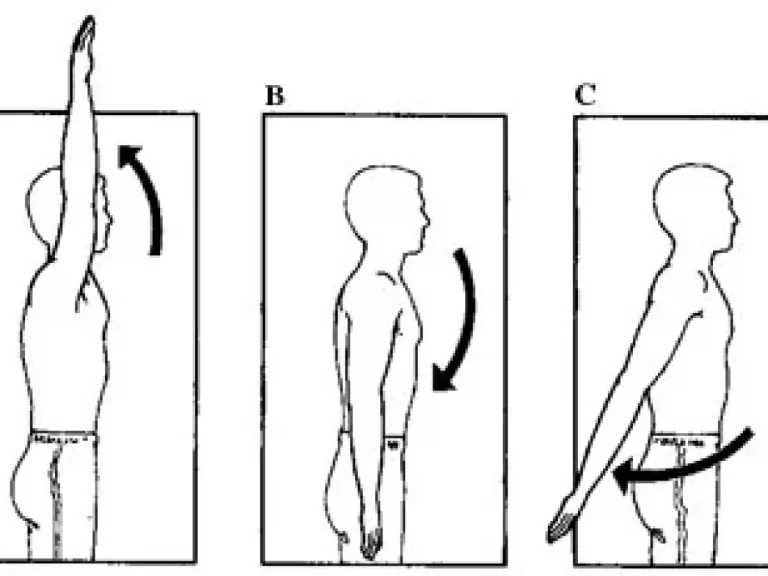


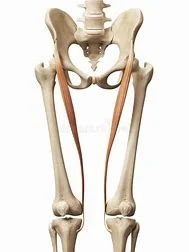
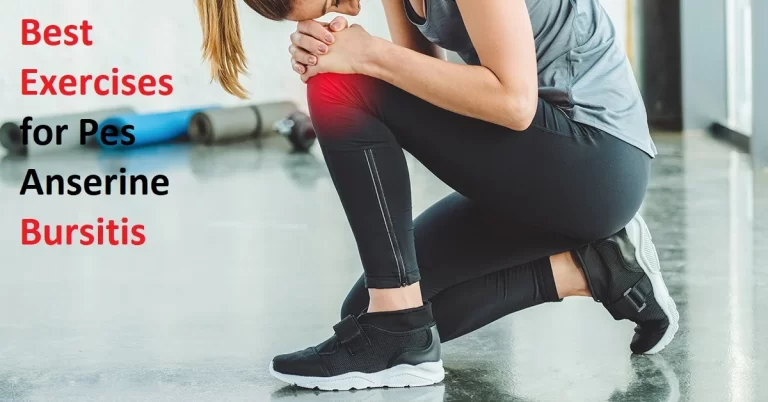
20 Comments